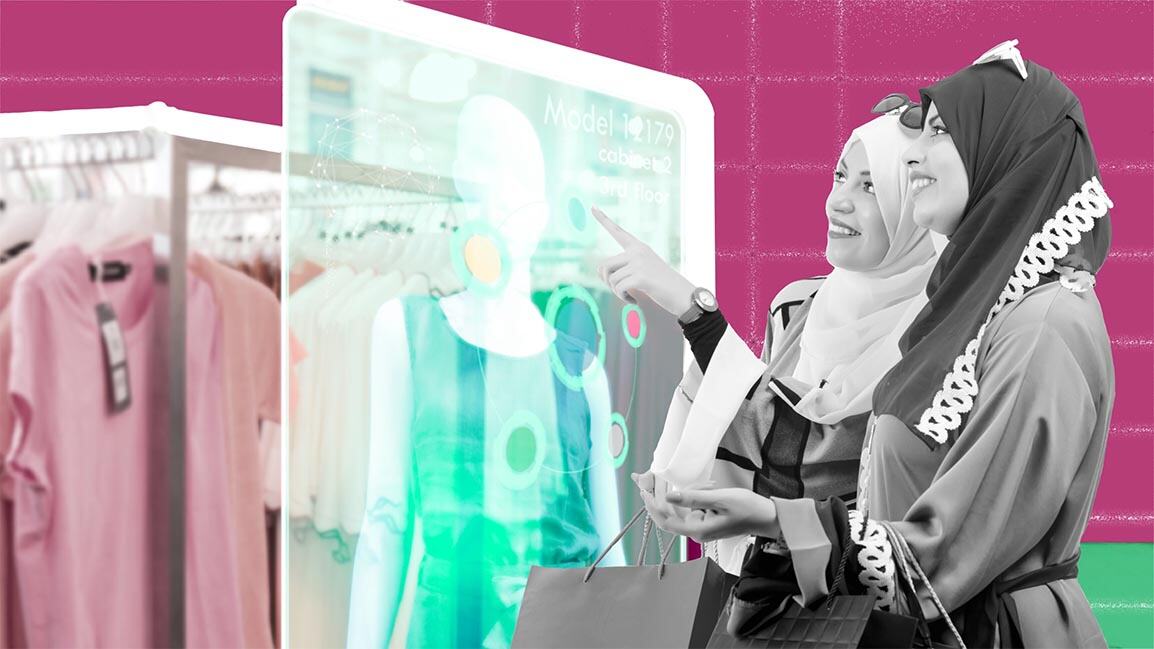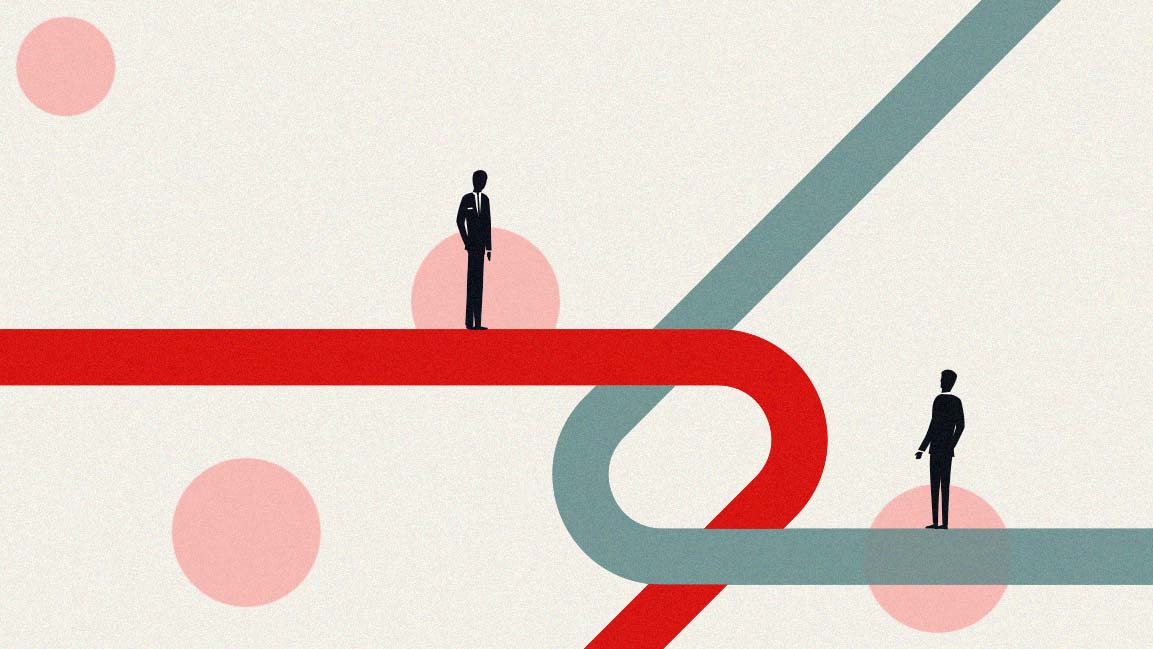- | 9:00 am
Let’s get phygital. Retail customer experience is transforming in the Middle East
Maximizing online and offline worlds is becoming retailers' top priorities, as consumers are beginning to demand unique experiences.

New technologies are emerging, and showrooms are the playground for retailers’ digital experiments. After two years of little to no need for new dresses, imagine the surprise when Samirah, whose taste has evolved with the convenience of digital shopping, entered the reimagined store, where flowers sprout from the polished floor, under a domed starry night sky, and her friends joined her shopping visit via Zoom-like video screens.
In the interactive fitting room, also called the “becoming” room, she could select from thousands of fawned-over dresses—each garment looks real, down to every stitch— add sizes or color preferences, and scan to see a video of how each dress was created.
To make your trip to the store or mall worth the time and energy, now stores are being designed to offer the best of both the physical and virtual worlds, turning into a third mode of shopping that resembles neither stores nor websites.
During the pandemic, when ecommerce boomed, coupled with widespread store closures, many predicted the death of physical stores. In some ways, they were right. Many stores did close down in the Middle East, while the ecommerce market is expected to reach $49 billion in 2025, surging from $31.7 billion last year. This prompted brands to question brick-and-mortar retail’s value in a post-pandemic world.
The reality, however, is that the rapid digitization of commerce is transforming the role of the physical store, and retailers are evolving to meet the ever-changing needs.
Legacy businesses are exploring new digital frontiers in the Middle East, from launching a virtual Dubai Mall to opening Lulu Hypermarket’s online shopping service and Carrefour’s click-and-collect service. On the other hand many digital native businesses are now exploring physical retail, tapping into the rise of the experience economy. Online retailer 6thStreet.com teamed up with Nanovo to launch a phygital store—a mix of the physical and the digital—in Dubai Hills Mall.
THE FUTURE OF SHOPPING IS PHYGITAL
Today’s retail environment is tied to the less tangible yet critical value of experiential engagement that physical retail can offer. Retailers are increasingly realizing that these elements are fundamental to long-term consumer loyalty, brand reputation, differentiation, and, ultimately, sales.
Physical stores can still play a critical role in ensuring customers have the most positive overall experience when they visit, thus increasing the chances for repeat purchases and visits.
“Despite the recent ecommerce boom, we are witnessing transformations across retail’s physical stores. We’ve seen three times growth in our omnichannel customers, and the share of omni customers in our base vs. single-channel customers has increased by four times,” says Hani Weiss, CEO of Majid Al Futtaim Retail.
“As a result, we see value in physical stores; however, they need to be reimagined using technological advancements to enhance customer experience and efficiency. This creates new opportunities for digitally driven brick-and-mortar initiatives.”
Brands are urgently shifting their efforts towards consumer engagement in the digital world. If anything, the last two years have taught the retail sector that it needs the agility to pivot rapidly.
“The phygital approach is now widely adopted throughout the region. With fast-changing purchasing behaviors, and as retailers become aware of the necessity to offer a unique customer experience to satisfy new needs, failing to transform and opt for this new model will have profound implications for retailers and could see them left behind or fall out of favor with consumers,” says Weiss.
“The phygital store is a game-changer for retailers because it bridges the gap between customers’ online browsing habits and history and their buying decisions on the shop floor, allowing the brand to harness data that is much richer and in-depth and utilize it to make more informed business decisions,” says Dadi Motiwalla, Managing Director– MENA & Asia-Pacific, Nanovo.
While brands in the region are evolving their ecommerce strategy, they are also evolving the way they measure the impact of their physical stores. Maximizing online and offline worlds is becoming one of the retailers’ top priorities, as consumers are beginning to demand unique experiences as table stakes in the battle for share of the wallet.
“The rise in online shopping calls for a rethink of how retailers interact with their customers,” says Mohammad A. Baker, Deputy Chairman and CEO of GMG.
According to him, an interesting retail dynamic is the GenZ shopper’s rise, a demographic with $360 billion in disposable income. “This born-digital generation of shoppers, despite their spending power, are value-driven when looking to make a purchase,” says Baker. “This highlights the need for brands to look at ways to attract their attention.”
In the digital era where “experience” is everything, there’s pressure on retailers to ensure online shopping and in-store experience are engaging. “Superior customer experiences increasingly depend on personalization and consistency. Customers expect retailers to understand them, anticipate their needs,” adds Baker.
TECHNOLOGY AT DISPOSAL
To differentiate themselves, brands are examining how their brick-and-mortar stores fit with their omnichannel strategy and what function they provide, be it service fulfillment, marketing, or client acquisition.
While online retailers have started opening physical stores to facilitate and expand customer discovery and connection, Nick Curran, Head of Endava MENA, says consumers are more interested in purchasing experiences than products.
“Therefore, retailers need to elevate the experiences at their stores with AR and VR to augment the customers’ shopping experience. Moreover, retail stores can use AI tech to optimize their layouts, reducing queues and increasing conversions,” adds Curran.
Until recently, offering a seamless, unified experience at scale was challenging. Today, however, AI enables retailers to foresee and realize new opportunities. “Armed with interconnected data sources and AI-powered analytics, retailers can gain a deeper understanding of their customers, anticipate their needs, and create scalable, personalized shopping experiences,” says Amr AlMasri, Regional Director, Genesys Middle East.
Since customers expect personalized service, retailers must implement digital technologies to customize experiences.
“One of the ways retailers can provide more personalized experiences for customers is through developing apps or portals that create omnichannel experiences,” says Rodrigo Castelo, Vice President MEA at OutSystems.
Not only do retailers need to tune user experiences as they get feedback from clients, but Castelo says they must also “launch new functionality or digital products on top of their existing digital properties to stay ahead of the competition.”
Technology undoubtedly offers retailers opportunities to stand out, attract new customers, and outperform their competitors. “While each retailer’s customer experience strategy will depend on their circumstances, a few universal truths apply,” says Baker.
And these include investing in a user-friendly mobile experience, personalization and customer loyalty, and timely responses to customer queries. “We can not lose the human element and a level of authenticity with each interaction,” says Baker.
FRICTION-FREE SHOPPING
The last two years have accelerated a rising trend in customer experience offering and demand for phygital and friction-free shopping experiences in retail stores, including the last-mile fulfillment of orders.
According to Weiss, there is an opportunity in click-and-collect, which is growing in popularity for traditional retailers such as Carrefour. He says services like that could create engaging brand experiences for customers when they pick up items, which might compel them to shop in-store more.
“Today, from a customer perspective in the Middle East, we continue to witness the appetite and expectation for such shopping experiences – demonstrating the link between new technological developments in the retail sector and the growing demand for customer experience innovation,” adds Weiss.
Predicting customer behavior and connecting every moment of a customer’s journey is the key to delivering a superior experience, says AlMasri. “Customers have higher expectations from retailers,” he says.
“For years, savvy retailers have endeavored to tailor customer experiences. But customers increasingly want more than just tailored interactions. They expect retailers to link these experiences to create empathetic, seamless, personalized journeys. Retailers must combine data and strategy to connect these moments,” adds AlMasri.
APPEAL FOR PHYSICAL STORES
Ultimately, customers buy into warm, personal connections more, which can’t be replicated in the comparatively cold digital environment.
While ecommerce has exploded in the last three years, the appeal of physical stores remains strong in the region where shopping malls are part of the social fabric. Malls play a significant cultural role in the region. According to a PwC report, 56% of Middle East consumers prefer visiting physical stores.
“Malls are not merely places to shop but venues for social interactions and catching up with friends, a sort of modern majlis,” says Baker. “So physical stores are here to stay.”
“The region has such a famous retail landscape that it is obvious consumers would stay loyal to real-life retail,” says Kate Hardcastle, a consumer expert. “While other territories have seen brands take very different views—-we have seen major brands on rapid store closure programs, and big names like Debenhams have left the high street forever. In the Middle East, however, retail is evolving.”
Today, personalization is key. “Customers are more likely to keep coming back to you if you can personalize their experiences,” says Curran. “This type of customization is highly predictive, and therefore the value lies in how you utilize customer data to predict what people may do in the future and use it as a reference for the past.”
Customers are looking for convenience and a smart shopping experience, and regional retailers are merging bricks-and-clicks to create a more cohesive, interconnected shopping experience for their customers.
According to experts, the phygital trend is driven by a desire to tap into the rise of the experience economy–people choosing to buy experiences over products and the rising costs of digital marketing. The over-saturation of DTC brands can significantly reduce gains made by saving on the overhead of physical space.
Also, the phygital approach of buying online, picking up in-store, or buying online, return in-store approaches give the physical store a fulfillment role that removes the need for an expensive warehouse, making e-commerce and physical retail interdependent.
Reiterating this idea, Motiwalla says phygital stores, with their interactive fitting room and tablets, will also evolve further into convenient modern-day pick-up points where online customers will have the satisfying experience of scheduling the use of a fitting room to try on their online shopping choices or pick up the purchases they have previously made online.
“The beauty of the model is that the customer doesn’t miss out on the social aspect of shopping and doesn’t have to deal with the challenges of shipping times, limited inventories, or waiting in long check-out lines,” adds Motiwalla.
In the end, it’s about understanding the different needs of customers and meeting them in interesting and quirky ways, not just online and offline, but the link between them all.








































